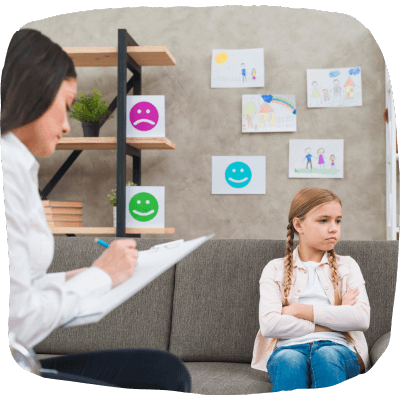The Urgency of Prioritizing Youth Mental Health Care

In today’s fast-paced and interconnected world, the mental well-being of our young population is more critical than ever. While society often emphasizes physical health, the state of youth mental health demands our immediate attention. A rapidly changing environment, increased academic pressure, and the pervasive influence of social media contribute to the growing prevalence of mental health issues among young people. It is imperative that we address these challenges head-on and provide comprehensive mental health care for our youth.
The Rising Crisis
The statistics surrounding youth mental health are alarming.
According to recent studies, approximately one in five adolescents experiences a mental health disorder, with depression and anxiety being the most common.
Unfortunately, many of these cases go unnoticed or untreated, leading to long-term consequences for the individuals and society as a whole.
From impaired academic performance to strained relationships and an increased risk of substance abuse, untreated mental health issues can have far-reaching effects.
Why are mental health issues increasing in youth?
There are several factors contributing to the increasing prevalence of mental health issues in youth:
- Changing Social Environment
The social landscape has transformed dramatically in recent years, with the rise of social media and the constant connectivity it brings. Young people are exposed to an overwhelming amount of information, peer pressure, and comparison, leading to increased stress, anxiety, and a distorted sense of self-worth.
- Academic Pressure
The education system has become more competitive, placing immense pressure on students to excel academically. High expectations, excessive workload, and intense competition can lead to burnout, anxiety, and depression among young people.
- Economic Uncertainty
Economic instability and the changing job market create a sense of uncertainty about the future for many young people. Financial pressures and a lack of job prospects can contribute to anxiety and stress, impacting their mental well-being.
- Family Dynamics
Family plays a crucial role in shaping a young person’s mental health. Dysfunctional family dynamics, lack of support, parental stress, or a history of mental health issues within the family can increase the risk of mental health problems in youth.
- Traumatic Experiences
Exposure to traumatic events, such as abuse, violence, or loss, can have a significant impact on a young person’s mental health. Trauma can lead to conditions such as post-traumatic stress disorder (PTSD), anxiety disorders, or depression.
- Lack of Access to Mental Health Care
Despite the increasing awareness of mental health issues, many young people still face barriers when trying to access appropriate care. Limited availability of mental health services, long waiting times, and financial constraints prevent some youth from receiving timely and adequate support.
- Stigma and Societal Attitudes
Stigma surrounding mental health is a persistent barrier to seeking help. Young people may fear judgment or discrimination, which discourages them from discussing their mental health concerns openly or seeking professional help.
It is important to note that the causes of mental health issues in youth are complex and multifaceted. While these factors contribute to the increasing prevalence, each individual’s experience is unique, and it is crucial to approach mental health care in a holistic and personalized manner.
7 information about the impact of social media on the mental health of young people

Social media can have both positive and negative effects on mental health. While it has the potential to connect people, provide support, and facilitate self-expression, it also comes with various challenges and risks that can impact mental well-being. Here are some ways in which social media can affect mental health:
- Comparison and Self-Esteem
Social media platforms often present a curated version of people’s lives, highlighting the positive aspects and achievements. Constant exposure to these idealized representations can lead to feelings of inadequacy and lower self-esteem as individuals compare themselves to others. The pressure to maintain a certain image or meet societal standards can contribute to anxiety, depression, and body image issues.
- Fear of Missing Out (FOMO)
Social media feeds are filled with exciting events, gatherings, and experiences, which can induce FOMO in individuals who feel they are missing out on social activities. This fear of missing out can increase anxiety and feelings of loneliness or isolation.
- Cyberbullying and Online Harassment
The anonymity and distance provided by social media platforms can facilitate cyberbullying and online harassment. Negative interactions, hate speech, or the spreading of rumors can significantly impact a person’s mental well-being, leading to increased stress, anxiety, and even suicidal ideation.
- Sleep Disturbances
The use of social media late at night or excessive screen time before bed can disrupt sleep patterns, leading to sleep disturbances. Inadequate sleep can have detrimental effects on mental health, contributing to mood disorders, decreased cognitive functioning, and overall well-being.
- Validation and Self-Worth
The pursuit of validation through likes, comments, and followers on social media can create a dependency on external approval for self-worth. This can lead to feelings of anxiety, low self-esteem, and even addictive behaviors, as individuals constantly seek validation from others.
- Information Overload and Media Influence
Social media inundates users with a constant stream of news, opinions, and information. The exposure to a vast amount of information can be overwhelming and lead to increased stress and anxiety. Moreover, the spread of misinformation or harmful content on social media platforms can contribute to confusion, fear, and mental distress.
- Social Isolation and Loneliness
Paradoxically, excessive use of social media can contribute to social isolation and feelings of loneliness. While individuals may have hundreds of online connections, the lack of meaningful face-to-face interactions can impact mental health, as genuine social connections are essential for well-being.
It is important to note that the impact of social media on mental health varies among individuals, and not everyone will experience negative effects. However, it is crucial to use social media mindfully, set boundaries, and prioritize real-life relationships and self-care activities to maintain a healthy balance between the digital world and mental well-being.
The Importance of Early Intervention in Youth Mental Health
Addressing mental health issues in young individuals is a pressing concern that requires proactive measures and a comprehensive approach. Among these strategies, early intervention stands out as a vital component in minimizing the long-term impact of mental health challenges. By recognizing signs of distress, providing timely support, and fostering collaborative efforts, we can effectively address the mental health needs of young people.

- Early Identification and Awareness
Early intervention begins with the identification of mental health concerns in young individuals. Parents, educators, and healthcare professionals play pivotal roles in recognizing signs of distress, such as changes in behavior, mood, or academic performance. Increasing awareness about common mental health issues among these stakeholders is essential to ensure early identification and appropriate intervention.
- Mental Health Education in Schools
Schools serve as key settings for early intervention. By prioritizing mental health education, schools can equip teachers, students, and parents with the necessary knowledge and skills to identify and address mental health challenges. Comprehensive mental health education programs can include recognizing signs of distress, promoting well-being, and fostering resilience in young individuals.
- Training and Resources for Educators
Educators should receive specialized training to enhance their understanding of mental health issues and improve their ability to support students in need. Training programs can equip educators with the knowledge and skills to recognize signs of distress, provide initial support, and connect students with appropriate resources. Access to mental health resources, such as school counselors or mental health professionals, should be readily available within the school setting.
- Collaboration and Support Networks
Effective early intervention requires collaboration among various stakeholders, including schools, families, and mental health professionals. Establishing strong support networks ensures a comprehensive approach to addressing mental health concerns. Regular communication and collaboration between these entities enable early identification, timely intervention, and continuity of care.
- Accessible Mental Health Services
Accessible mental health services are crucial in facilitating early intervention. Schools and communities should prioritize providing resources and connections to mental health professionals for young individuals in need. This may involve partnerships with local mental health organizations, expanding mental health services within schools, and addressing barriers to access, such as affordability and transportation.
- Teletherapy and Online Support
The rise of teletherapy and online support platforms has the potential to greatly enhance accessibility to mental health care. These digital resources allow individuals to access therapy sessions and support from the comfort of their own homes, eliminating geographical barriers and reducing transportation costs. Expanding teletherapy options and ensuring internet access in remote areas can significantly improve access to care.
- Accessible and Affordable Services
Ensure that young people have access to affordable and accessible mental health services. This can involve strengthening mental health services within schools, improving community resources, and reducing barriers to care such as cost, stigma, and transportation.
- Prevention and Promoting Resilience
In addition to early identification and intervention, prevention efforts are essential. Schools can focus on promoting resilience, well-being, and healthy coping mechanisms through programs and activities that build social-emotional skills. By fostering resilience in young individuals, we can help prevent the development or escalation of mental health challenges.
- Expanding Mental Health Resources
To improve accessibility, it is vital to invest in expanding mental health resources in communities. This includes increasing the number of mental health professionals, such as psychiatrists, psychologists, and counselors, to meet the growing demand for services. Governments and organizations should allocate funding to support the training and recruitment of mental health professionals, particularly in underserved areas.
13 tips to improve the mental health of young people
Improving the mental health of young people requires a comprehensive approach that involves individuals, families, schools, communities, and society as a whole. Here are some strategies to promote positive mental health among young people:
- The Stigma Barrier
Breaking down the stigma surrounding youth mental health is crucial to ensure that young people feel comfortable seeking help and receiving the support they need. Here are some approaches to address the stigma barrier:
- Community-Based Initiatives:
Community-based initiatives play a crucial role in increasing accessibility to mental health care. Local organizations, schools, and community centers can provide mental health programs, support groups, and workshops. These initiatives not only reduce the stigma surrounding mental health but also make services more accessible and familiar to young people.
- Education and Awareness
Promote education and awareness campaigns that provide accurate information about mental health conditions, their prevalence, and the importance of seeking help. These campaigns can target young people, parents, teachers, and the wider community to dispel myths, challenge stereotypes, and promote empathy.
- Mental Health Literacy
Incorporate mental health education into school curricula, teaching students about common mental health issues, coping strategies, and how to support others. By increasing mental health literacy, we can foster understanding, empathy, and early intervention.
- Role Models and Peer Support
Encourage individuals who have experienced mental health challenges to share their stories openly, acting as role models for others. Peer support programs can also create safe spaces for young people to connect, share experiences, and provide support to one another, reducing feelings of isolation and normalizing help-seeking behavior.
- Promote Positive Language
Use language that is respectful, non-judgmental, and inclusive when discussing mental health. Encourage the use of person-first language that emphasizes the individual over their condition, reducing the tendency to label or stigmatize individuals.
- Media Representation
Advocate for responsible and accurate portrayal of mental health in the media. Promote positive representations of mental health experiences and recovery to challenge stereotypes and show that seeking help is a sign of strength.
- Supportive Environments
Create safe and supportive environments within schools, communities, and workplaces where individuals can openly discuss mental health concerns without fear of discrimination or negative repercussions. Encourage the implementation of mental health policies and procedures that prioritize well-being.
- Role of Adults
Parents, teachers, and other influential adults should lead by example by openly discussing mental health, expressing empathy, and seeking help when needed. Their positive attitudes and actions can help reduce the stigma associated with mental health issues.
- Collaboration and Partnerships
Engage with mental health organizations, community groups, and stakeholders to collaborate on initiatives that aim to combat stigma and promote mental health awareness. Collective efforts can have a broader impact and reach more young people.
- Develop Coping Skills
Teach young people effective coping skills and resilience-building techniques to navigate challenges and stressors. This can include promoting problem-solving skills, emotional regulation strategies, and mindfulness practices that enhance their ability to manage and adapt to difficulties.
- Normalizing Help-Seeking
Emphasize the importance of seeking help for mental health concerns as a normal and necessary part of overall well-being. Encourage young people to view seeking support as a proactive step towards self-care and personal growth.
- Limit Screen Time and Digital Boundaries
Promote healthy boundaries around technology use and encourage young people to have offline activities, hobbies, and face-to-face interactions. Limiting excessive screen time can help reduce the negative impact of social media and online pressures on mental health.
By collectively working towards breaking the stigma associated with youth mental health, we can create an environment that supports open conversations, empathy, and early intervention. This shift will ultimately lead to improved access to care and better mental health outcomes for young people.
Accessible and Affordable Care: Breaking Barriers in Youth Mental Health
When it comes to youth mental health, accessibility and affordability of care are crucial elements in ensuring that all young people have the support they need. Unfortunately, numerous barriers prevent individuals and families from accessing professional help, including financial constraints and limited availability of mental health services. To address this issue, concerted efforts are required from governments, healthcare providers, and organizations to expand resources, reduce wait times, and create affordable options for mental health care.
- Creating Affordable Options:
Affordability is a significant barrier to mental health care. Governments, insurance providers, and healthcare systems must work together to create affordable options for individuals and families. This can include implementing mental health coverage within public and private insurance plans, reducing out-of-pocket costs, and providing subsidies or financial assistance for those who cannot afford treatment.
- Integrated Care
Integrating mental health care into primary care settings can enhance accessibility for young people. Collaborative care models that involve mental health professionals working alongside primary care providers ensure a holistic approach to addressing mental health needs. This integration reduces the burden on specialized mental health services and improves access for those who may not initially seek help from mental health professionals.
- Reducing Wait Times
Long wait times can deter young people from seeking mental health care. Efforts should be made to reduce wait times for assessments and treatment. This can be achieved through increased funding for mental health services, improved coordination among service providers, and streamlining referral processes. Additionally, early intervention programs and screening initiatives can help identify mental health concerns at an earlier stage, reducing the need for long waits.
The youth mental health crisis demands our urgent attention. By acknowledging the prevalence of mental health issues among young people, combating stigma, and providing accessible and comprehensive care, we can create a brighter future for the next generation. It is a collective responsibility of governments, educators, healthcare providers, and society as a whole to prioritize the mental well-being of our youth. Let us work together to build a world where no young person suffers in silence and where mental health care is readily available to all.



